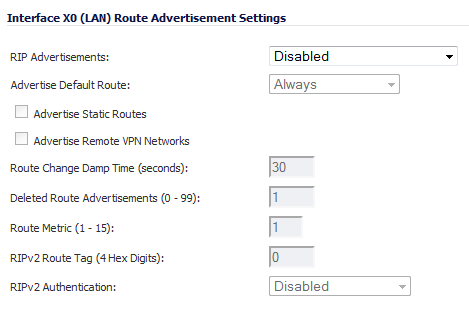
|
1
|
Click the Edit icon in the Configure column for the interface. The Interface Route Advertisement Configuration dialog displays.
|
|
2
|
Select one of the following types from the RIP Advertisements drop-down menu:
|
|
•
|
Disabled - Disables RIP advertisements and all options are dimmed.
|
|
•
|
RIPv1 Enabled - RIPv1 is the first version of Routing Information Protocol RIP.
|
|
•
|
RIPv2 Enabled (multicast) - Sends route advertisements using multicasting (a single data packet to specific nodes on the network).
|
|
•
|
RIPv2 Enabled (broadcast) - Sends route advertisements using broadcasting (a single data packet to all nodes on the network).
|
|
3
|
|
4
|
Enable Advertise Static Routes if you have static routes configured on the SonicWall security appliance and want to exclude them from Route Advertisement.
|
|
5
|
Enable Advertise Remote VPN Networks if you want to advertise VPN networks.
|
|
6
|
Enter a value, in seconds, between advertisements broadcast over a network in the Route Change Damp Time (seconds) field. The default value is 30 seconds. A lower value corresponds with a higher volume of broadcast traffic over the network.
|
The Route Change Damp Time (seconds) setting defines the delay between the time a VPN tunnel changes state (up or down) and the time the change is advertised with RIP. The delay, in seconds, prevents ambiguous route advertisements sent as a result of a temporary change in the VPN tunnel status.
|
7
|
Enter the number of advertisements that a deleted route broadcasts until it stops in the Deleted Route Advertisements (0-99) field. The minimum value is 0, the maximum is 99, and default value is 1.
|
|
8
|
Enter a value from 1 to 15 in the Route Metric (1-15) field. This is the number of times a packet touches a router from the source IP address to the destination IP address. The default value is 1.
|
|
9
|
If either RIPv2 option is selected from the Route Advertisements drop-down menu, you can optionally enter a value for the route tag in the RIPv2 Route Tag (4 HEX Digits) field. This value is implementation-dependent and provides a mechanism for routers to classify the originators of RIPv2 advertisements.
|
|
10
|
If you want to enable RIPv2 authentication, select one of the following options from the RIPv2 Authentication drop-down menu:
|
|
•
|
Disabled - This is the default value.
|
|
•
|
User Defined - When selected, two options appear:
|
|
•
|
Authentication Type (4 Hex Digits) - Enter 4 hex digits in this field. The default is 0.
|
|
•
|
Authentication Data (32 Hex Digits) - Enter 32 hex digits in this field. A default value is given.
|
|
•
|
Cleartext Password - When selected, an option appears:
|
|
•
|
Authentication Password (Max 16 Chars) - Enter a password in this field. A maximum of 16 characters can be used to define a password. A default password is given.
|
|
•
|
MD5 Digest - When selected, two options appear:
|
|
•
|
Authentication Key-Id (0-255) - Enter a numerical value from 0-255 in the field. The minimum value is 0, the maximum is 255, and the default is 1.
|
|
•
|
Authentication Key (32 hex digits) - Enter a 32 hex digit value for the field or use the generated key.
|
|
11
|
Click OK.
|